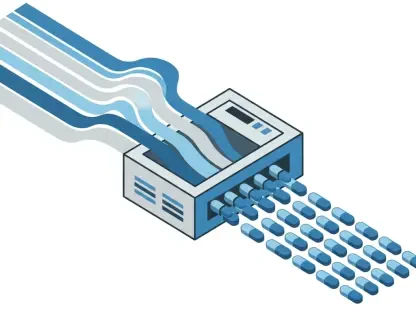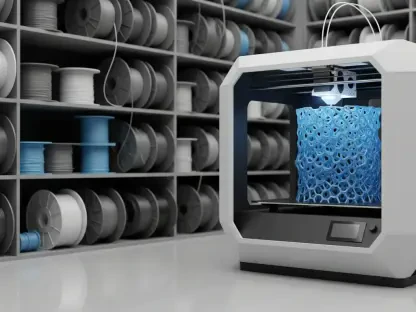Additive Manufacturing (AM) has revolutionized the industrial landscape, offering unprecedented flexibility and efficiency in creating complex and customized parts. However, as this cutting-edge technology advances, it brings along a set of unique cybersecurity challenges that traditional manufacturing processes seldom face. Understanding and addressing these challenges is critical for safeguarding the future of AM.
The Digital Backbone of Additive Manufacturing
The essence of AM lies in its digital nature. Unlike traditional manufacturing that relies heavily on physical tooling and human oversight, AM operates on digital files and interconnected systems. These digital schematics are essential for 3D printing operations but also represent a key vulnerability point.
Every step, from initial design to the final layer of material deposition, is controlled through digital instructions. The integrity of these digital instructions is paramount; any compromise can result in defective parts, financial losses, and safety risks. Therefore, ensuring the security of digital processes in AM is not just a preference—it’s a necessity.
The digital backbone of AM brings many benefits, including increased precision, rapid prototyping, and the ability to produce on-demand parts. These advantages, however, are counterbalanced by significant risks. The digital files that control the manufacturing process can be intercepted, modified, or stolen by malicious actors. A seemingly minor alteration in the design file can lead to catastrophic failures in the final product, underscoring the need for stringent cybersecurity measures.
The Threat of Design File Theft
One of the prime concerns in AM cybersecurity is the protection of design files. These files contain proprietary information and detailed instructions to manufacture specific parts. Unauthorized access to these files can lead to intellectual property theft and the production of inferior, unauthorized parts.
The value of these design files isn’t limited to their intellectual property. They can be manipulated to change specifications subtly, causing critical failures in the final product. Thus, companies must employ robust encryption protocols and secure file storage solutions to protect their digital assets from potential cyber threats.
Design file theft represents a significant threat not only to the company owning the designs but also to the entire supply chain. If compromised files are used to manufacture parts, the end products may fail, leading to a cascade of problems for downstream users. In industries such as aerospace, automotive, and medical devices, the consequences of such failures can be dire, potentially endangering lives. Therefore, the implementation of robust encryption and secure transmission methods is essential to safeguard these valuable digital assets.
Consequences of Cyber-Attacks in Additive Manufacturing
The repercussions of a successful cyber-attack in the AM domain are multifaceted and severe. Financial costs from disruptions in production aside, the reputation damage can be irreversible. Clients rely on the precision and reliability of AM-produced parts, and any breach undermines their confidence.
More alarmingly, cyber-attacks can pose direct safety risks. Altered designs or compromised materials can result in structural failures, endangering lives in applications such as aerospace, medical implants, and automotive industries. Therefore, manufacturers must adopt a proactive approach to mitigate these risks, including continuous monitoring and threat detection measures.
The economic impact of cyber-attacks is considerable. Production delays, the need to recall defective products, and potential legal liabilities can all drain financial resources. Furthermore, reputation damage often leads to a loss of current and potential clients. In highly regulated sectors, non-compliance due to cybersecurity breaches can result in hefty fines and restrictions, further exacerbating the financial toll on the affected company. Therefore, companies must prioritize a robust cybersecurity framework that includes regular assessments, continuous monitoring, and well-defined response protocols.
Sabotage and Unauthorized Manufacturing
In addition to theft, sabotage and unauthorized production are growing concerns. Cybercriminals can infiltrate AM systems to introduce flaws deliberately, resulting in defective and potentially dangerous parts. This sabotage can have cascading effects, particularly when compromised parts are integrated into larger systems or critical infrastructure.
The threat isn’t limited to malicious external actors. Internal threats from disgruntled employees or insufficiently vetted contractors can be just as damaging. Implementing stringent access controls and conducting regular audits are essential steps to prevent unauthorized access and tampering within the production environment.
The potential for sabotage extends beyond mere part defects. Cyber-attackers can target the manufacturing process itself, causing machines to operate incorrectly or use inappropriate materials. This kind of sabotage can be challenging to detect until significant damage has occurred, making regular audits and employee training on cybersecurity protocols crucial. Additionally, implementing comprehensive background checks for employees and contractors helps mitigate the risk of insider threats. By fostering a culture of security awareness and vigilance, companies can better protect themselves from both internal and external threats.
Supply Chain Compromise
The complexity of the AM supply chain introduces another layer of vulnerability. Suppliers play a critical role in the quality and integrity of the final product. However, a cyber-attack targeting suppliers can introduce compromised materials or faulty components into the manufacturing process.
Monitoring the entire supply chain and ensuring that all partners adhere to stringent cybersecurity measures is imperative. Collaborative efforts and transparent communication between suppliers and manufacturers can significantly reduce the risks associated with supply chain compromises.
Effective supply chain security requires a comprehensive approach. Manufacturers must perform due diligence when selecting suppliers, ensuring they follow robust cybersecurity practices. Furthermore, implementing end-to-end encryption and secure communication protocols helps protect the integrity of transmitted data. Regular audits and assessments of suppliers’ cybersecurity measures are also necessary to ensure ongoing compliance. By maintaining a transparent and collaborative relationship with suppliers, manufacturers can better understand and manage potential risks, thereby strengthening the overall cybersecurity posture of the entire supply chain.
Proactive Cybersecurity Measures for Additive Manufacturing
To navigate the growing landscape of cyber threats, AM companies must prioritize a multi-tiered cybersecurity strategy. Conducting comprehensive risk assessments is the foundational step. By understanding the specific vulnerabilities at each stage of the manufacturing process, companies can develop tailored security protocols.
Integrating cybersecurity considerations into the design phase is equally important. Secure design practices, including the use of robust digital watermarks, can prevent unauthorized alterations. Additionally, employing advanced monitoring solutions, such as non-invasive side-channel analysis, can detect potential threats in real-time, allowing rapid response and mitigation.
A proactive cybersecurity strategy involves not just reactive measures but also preventive steps. Companies should implement multi-factor authentication, regular software updates, and employee training programs on cybersecurity best practices. Establishing an incident response plan is also critical, providing a clear roadmap for identifying, containing, and recovering from cyber-attacks. By fostering a culture of security awareness and investing in advanced cybersecurity technologies, AM companies can better protect their digital assets and manufacturing processes from potential threats.
The Role of Regulatory and Legal Frameworks
As AM technologies evolve, so must the regulatory and legal frameworks governing them. Current regulations lag behind the rapid technological advancements, leaving gaps that can be exploited by cybercriminals. It is crucial for lawmakers to establish clear guidelines and standards to address the cybersecurity challenges unique to AM.
Compliance with established security standards, such as the U.S. Department of Defense’s STIGs, ensures that AM processes adhere to best practices in cybersecurity. These standards provide a structured approach to configuring and maintaining secure systems, which is vital for protecting sensitive manufacturing data.
Regulatory frameworks play a vital role in shaping the cybersecurity landscape. By setting stringent requirements for data protection, access controls, and incident reporting, regulators help create a baseline for industry-wide security practices. However, the rapid pace of technological advancements necessitates that these frameworks be dynamic and adaptable. Continuous collaboration between industry leaders, regulatory bodies, and cybersecurity experts is essential to develop and update regulations, ensuring they effectively address emerging threats and vulnerabilities in the ever-evolving field of AM.
Collaboration Across the Ecosystem
Additive Manufacturing (AM) has transformed the industrial sector by offering unparalleled flexibility and efficiency for creating intricate and bespoke parts. This innovative technology allows for the production of items that were once impossible or highly impractical with traditional manufacturing methods. However, the rapid advancement of AM also brings a unique set of cybersecurity challenges. Unlike conventional manufacturing, which primarily focuses on physical processes, AM relies heavily on digital data and computer networks. This dependency on digital infrastructure makes it vulnerable to cyber threats.
Cybersecurity in AM involves safeguarding digital designs, ensuring the integrity of production files, and protecting the entire supply chain from malicious attacks. Hackers could potentially alter design files, leading to the production of defective or dangerous parts. Additionally, intellectual property theft is a significant concern, as unauthorized access to proprietary designs can result in substantial financial losses and damage to a company’s competitive edge.
Addressing these cybersecurity challenges is essential for the continued growth and adoption of AM. Companies must invest in robust cybersecurity measures, such as advanced encryption, regular software updates, and comprehensive employee training to protect their digital assets. As AM technology continues to evolve, so must the strategies to secure it, ensuring a safe and innovative future for the industry.









